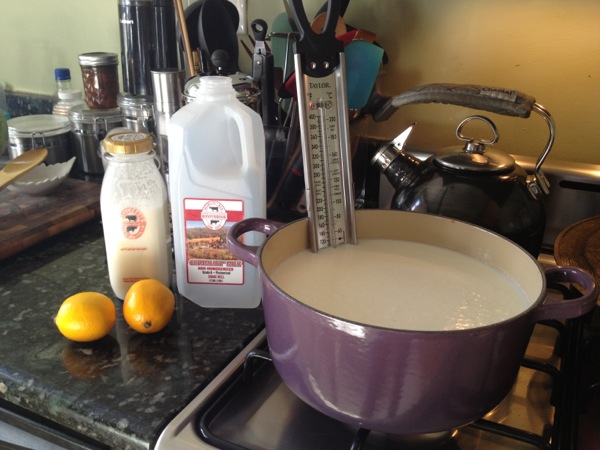DIY project #1 ricotta cheese!
So here goes, DIY project #1 from The Homemade Pantry 101 Foods You Can Stop Buying & Start Making, ricotta cheese!!!!
I hear it's not that hard to make cheese. I heard right! I'm not a big ricotta eater, neither is my mom, but over the past few years I have grown a love of the creamy cheese on toasts topped with grilled peach slices at a summer BBQ or drizzled with a touch of sea salt and honey. This time I decided it was time for a Sunday lasagna (recipe also in the book) and what better way to start my project than making my ricotta from scratch? I followed the recipe from start to finish and I think it's pretty delicious. I did drain in a bit longer than the book specified since I like a less watery cheese and I wanted something with a little more texture in my lasagna. I did taste it before it went in, and have to admit, it was pretty damn good.
Since it was Sunday, I went to the farmer's market after my morning workout and found some low heat pasteurized milk and heavy cream. (It's not legal to sell unpasteurized raw milk in NYC or I would have done it completely raw which I hear is the best.) I found a farmer who said he and his father have used his milk to make cheese with great results. That was enough for me so I bought a half gallon of whole milk and a pint of heavy cream but not before chatting him up and determining that his cows were all grass fed and humanely treated in the milking process. I think he was happy to have someone willing to chat with him in the frigid wind and after a promise of bringing my glass bottle back for my $1.50 deposit and a sample of my ricotta if I have any leftover along with a promise that he would bring me some of his father's cheese, I was on my way.
I ran over to the grocery store to pick up the ingredients I needed for lasagna along with the 2 lemons I would need to separate the curds from the whey in my milk and cream and headed home. About an hour after I arrived home, I had ricotta cheese!
RECIPE
1/2 GAL MILK
1/2 C HEAVY CREAM (optional)
1/3 C LEMON JUICE (about 2 lemons)
Pour milk, cream and lemon juice in a heavy bottom pot. Mix to combine and attach thermometer. Place pot over low heat and bring temp up to 175 degrees (about 50 min) stirring once or twice. Raise flame to med-high and bring temp to 205 degrees (about 3-5 min) without stirring. Milk should look like it's about to erupt but NOT boil. The solids on the top are curds and the liquid is whey. Remove from heat and allow to stand for 10 min. Set a sieve with a double layer of cheese cloth over a bowl and spoon curds in to the sieve. Allow to drain for 10 min (I let mine drain about 20 min so it was a more solid cheese). Sprinkle with salt if you like your ricotta a bit saltier.
NOTE : The cloudy liquid left after draining is whey and is high in nutrients and protein and can be used in place of milk or water in some baking recipes. It can also be used in place of water or stock for soups.


